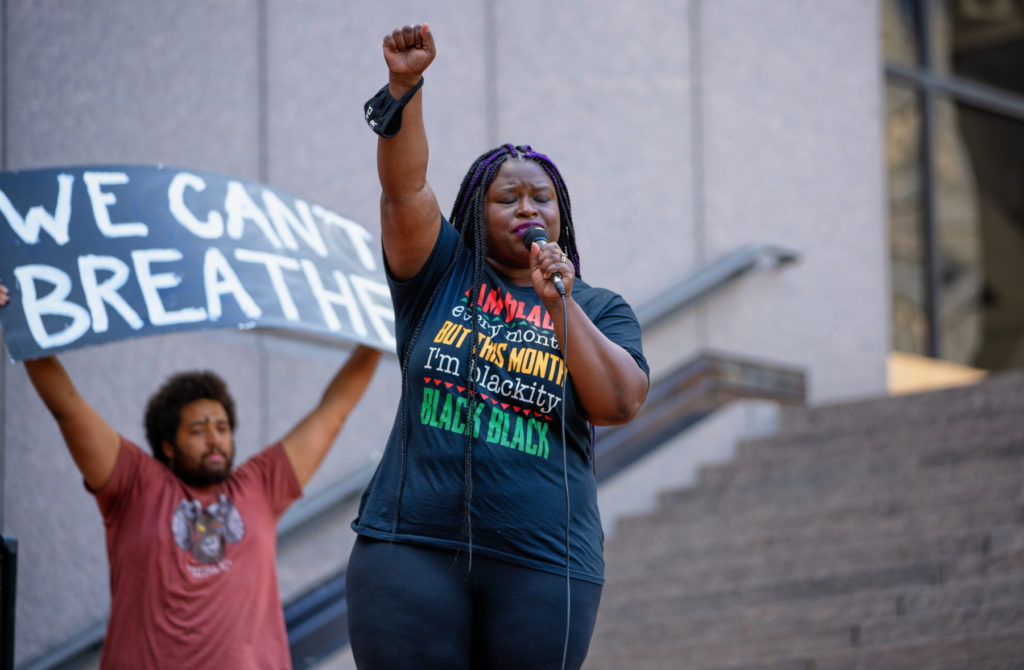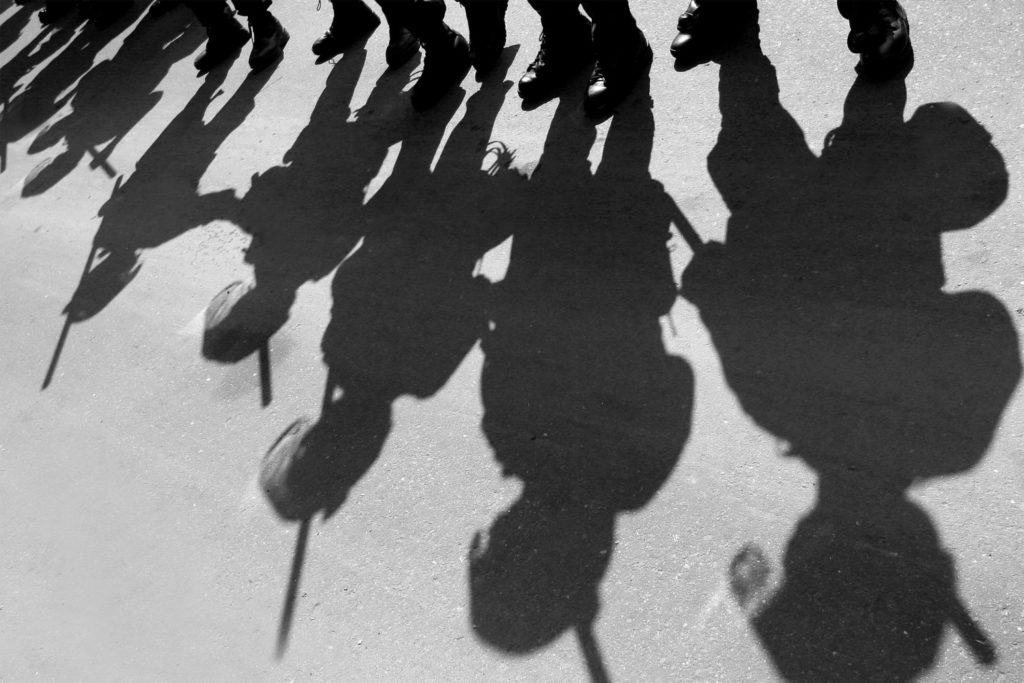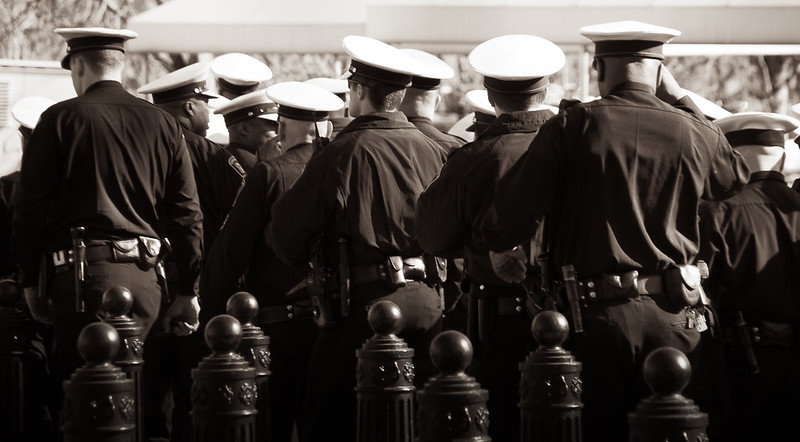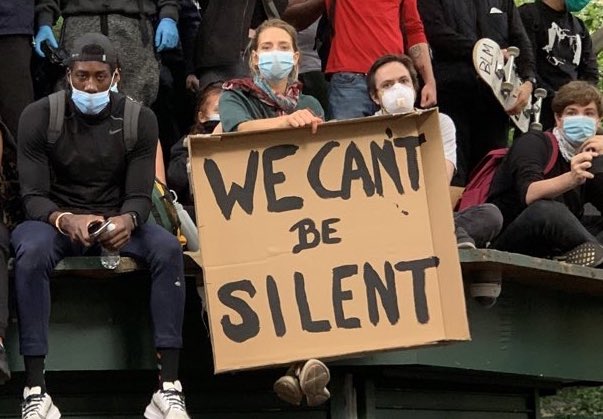
The police killing of George Floyd and the nationwide protests it sparked will forever be haunted by the simple fact that Floyd would never have died if only one member of the group of police who responded to that call had intervened to force Officer Derek Chauvin to release his knee from the man’s neck.
Three sworn officers of the Minneapolis Police Department—all adult men—were in a position to interrupt their fellow officer’s abusive behavior and save Floyd’s life. But none did.
Social scientists and armchair analysts alike will debate for years about why this happened. Some will attribute the failure to anti-Black racism and the long history of police abuse toward African-Americans. Some will focus on the deeply entrenched, authoritarian culture of law enforcement.
To those explanations, I would add the gendered dynamic of men in cohesive groups like teams, military units and law enforcement agencies, especially in relation to their roles and responsibilities to themselves and each other. The cruel killing of George Floyd by agents of the state—caught on video—has rightly focused attention on police practices in communities across the country.
Chauvin’s fellow officers have all been charged with “aiding and abetting murder”—which takes the idea of accountability to a much higher level.
But if we want to understand why horrific incidents like this continue to occur, instead of always reacting after the fact, we need to ask and answer a series of questions that have implications well beyond law enforcement:
- What were the interpersonal and group dynamics at play between and among those four police officers?
- Were ethnic and racial tensions a factor not only between the officers and Floyd, but between the officers themselves?
- If any of Chauvin’s colleagues were uncomfortable with or didn’t agree with how he was handling Floyd, why didn’t they act?
- How do norms in male-dominated peer cultures like police departments operate to keep men silent, even when they know something is wrong?
As one of the early architects of the “bystander” approach to prevention in the gender violence prevention field, I and my colleagues have wrestled with these sorts of questions for nearly three decades in trainings with hundreds of thousands of men (and women) in intense, multiracial, male-dominated environments on college and professional athletic teams, in college fraternities, in military units in all of the armed services, and in police departments.
This work has focused primarily on the prevention of sexual harassment, sexual assault and domestic violence. But in our experience, we know that the behavior of bystanders facing misogynous violence or heterosexist abuse can appear remarkably similar to the behavior of bystanders in instances of racist confrontation.

What follows are some observations about these overlapping characteristics.
It is important to note that none of the ideas outlined below take the place of critiques of systemic racism or sexism, or even how such oppressions manifest themselves in larger organizations such as big city police departments. Rather, they are attempts to explain how key features of these systems are operationalized at the small group level.
The calculus for intervention differs when it’s a “stranger” situation—versus one that involves “known” peer cultures.
The factors that inhibit bystander action are quite different depending on whether people know each other or not.
Many people do not want to get involved in situations of potential harassment or violence in which they don’t know the parties involved, largely out of fear of putting themselves at physical risk. Social psychologists use the term “bystander effect” to describe the ways in which people avoid taking action; for example, as members of a crowd, they might be waiting, or hoping, for someone else to jump in.
By contrast, in incidents where the bystanders know the people—such as members of their own personal or workplace peer culture—their hesitancy to get involved is typically based on social fear. They worry that intervening will be awkward and could result in the loss of friendships, social status, or professional standing. Think about men and their friends in college fraternities, on sports teams, in c-suites or blue-collar workplaces.
The Floyd case featured both kinds of bystander. A number of passersby saw Floyd on the ground with Chauvin’s knee on his neck, and heard Floyd complaining that he couldn’t breathe. Unlike many people who are afraid to intervene in violent situations in public settings out of their understandable fear of violent retaliation, they pleaded with Chauvin to release Floyd.
In stark video footage of the incident, you can hear people imploring Officer Tou Thao to step in and stop Chauvin from killing Floyd.
These bystanders did the right thing; unfortunately, their words went unheeded.

But the most consequential bystanders were not strangers to the relevant parties. They were Chauvin’s fellow officers. It is possible they all complied with Chauvin’s instructions because they agreed with him—although one of the rookie officers, Thomas Lane, asked, “Should we roll him on his side?”
Nonetheless, their failure to intervene and prevent or interrupt Chauvin’s crime was likely due less to their physical fear of violent retribution, than to their fear of social and perhaps professional repercussions.
As former Boca Raton police chief Andrew Scott told the Associated Press, “Departments often don’t reward officers for interfering with their colleagues or reporting that they broke policy.” Officers who do intervene “risk being ostracized by their fellow officers and branded as an informer in the ranks.
“In law enforcement, if you’re considered an individual who can’t be trusted, you’re not going to have the timely back-up from other officers,” Scott said. “That’s a legitimate fear factor.”
Gender is a central factor in defining the protocols of bystander intervention.
Men commit the vast majority of violence against people across the gender spectrum, so any serious effort to reduce violence needs to grapple with the specific dynamics of male peer cultures.
Whether it’s called a boy code, a guy code, or a bro code, a set of unwritten rules governs the behavior of individuals in all-male or male-dominated groups. This is especially true of groups engaged in aggressive competition and “us versus them” battles with other groups—such as in sports and politics, and is even more pronounced in military or para-military organizations such as the police.
Men who fail to demonstrate “bravery,” or a willingness to use force under certain conditions, are often branded as “soft” and “weak,” and consequently lose status. This branding as a form of bullying can be witnessed in the actions of the president of the United States, who reinforces the acceptability of this form of harassment when he regularly describes political opponents this way.
Some men hesitate to intervene when they see a friend, teammate or co-worker behaving inappropriately or abusively not because they approve of the behavior, but because they lack the language, skills and most importantly, the self-confidence to speak up.
The pressures on men—especially young men—from all ethnic and racial backgrounds to do whatever it takes to be “one of the guys” can be intense. Sometimes remaining silent even when you know you should say something is the cost of membership in the club. But while staying silent might be the path of least resistance, the Floyd killing shows that silence and inaction can also have extraordinarily negative consequences.

My colleagues and I have heard countless stories over the years from men who wish they had had the courage—at the moment of truth—to confront their buddies and stop them from doing something harmful—to the victim, first and foremost, but also to others, and even to the perpetrators themselves.
Which is why one collateral benefit of prosecuting officers who commit criminal behavior in the line of duty is that it would provide a countervailing pressure on officers on the street, who would otherwise be reticent to speak up in the heat of the moment.
Former New York City police sergeant Joseph Giacalone, who now teaches at the John Jay College of Criminal Justice, explains why:
“This is a lesson for every cop in America,” he said. “If you see something that is wrong, you need to step in. There are a lot of gray areas in policing, but this was crystal clear. … You’re better off being ostracized by the group than going to prison for murder.”
Status hierarchies within peer cultures can function to enforce silence.
Members of teams, military units and law enforcement agencies share not only mutual goals, but often deep bonds of friendship and camaraderie. The downside is that individuals are expected to conform to the rules of hierarchy and not challenge group norms, or risk social penalties and in some cases social or professional suicide. These norms can encourage and reward either prosocial or antisocial behavior.
The respect for status hierarchies in most male-dominated social or professional peer cultures has obvious implications for bystander behavior, because men who are younger, or who have less social status or power know they risk a great deal if they call out abusive behavior by more senior or more popular colleagues—regardless of what it says in the team’s code of conduct or workplace employee handbook.
Derek Chauvin was a 19-year veteran of the Minneapolis PD, whose record showed a string of complaints, and whose duties included being a training officer for new officers. Two of the men charged with aiding and abetting his murder of George Floyd were rookie cops. One of them was on his fourth day on the job.
Were these men intimidated by Derek Chauvin? If so, it does not absolve any of them for their actions or inactions on May 25. But one would have to be willfully naïve to think Chauvin’s power and status within the hierarchy didn’t factor into why no one stopped him.
Finally, the police killing of George Floyd raises larger questions about silence and complicity. From the beginning of the Civil Rights Movement to the present moment, African-American activists and intellectuals have called on white people to take a stand against racism. Feminists adapted this approach when they challenged men to oppose sexism and male privilege.
For white people, the first step might mean speaking up when you witness an individual perpetrating an act of overt or even subtle racism.
But as participants in a democracy that continues to struggle with widespread and deep injustice and inequality, all white people who are not actively engaged in working against racist systems are, in a sense, passive bystanders.





